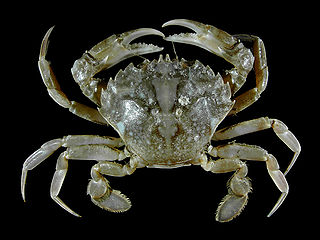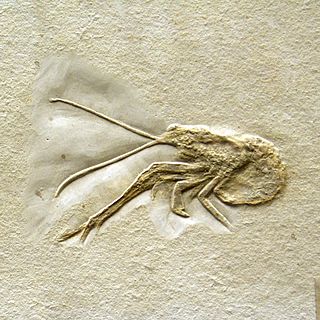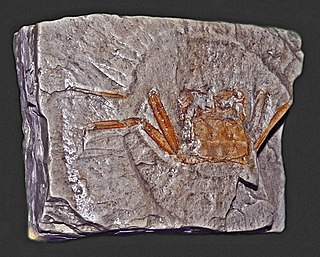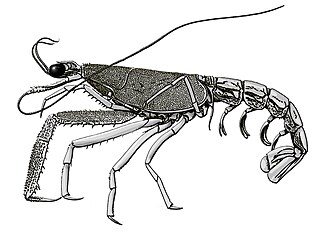
Crabs are decapod crustaceans of the infraorder Brachyura, which typically have a very short projecting "tail" (abdomen), usually hidden entirely under the thorax. They live in all the world's oceans, in freshwater, and on land, are generally covered with a thick exoskeleton, and have a single pair of pincers. They first appeared during the Jurassic Period.

Copepods are a group of small crustaceans found in nearly every freshwater and saltwater habitat. Some species are planktonic, some are benthic, a number of species have parasitic phases, and some continental species may live in limnoterrestrial habitats and other wet terrestrial places, such as swamps, under leaf fall in wet forests, bogs, springs, ephemeral ponds, and puddles, damp moss, or water-filled recesses (phytotelmata) of plants such as bromeliads and pitcher plants. Many live underground in marine and freshwater caves, sinkholes, or stream beds. Copepods are sometimes used as biodiversity indicators.

The Decapoda or decapods are an order of crustaceans within the class Malacostraca, including many familiar groups, such as crabs, lobsters, crayfish, shrimp and prawns. Most decapods are scavengers. The order is estimated to contain nearly 15,000 species in around 2,700 genera, with around 3,300 fossil species. Nearly half of these species are crabs, with the shrimp and Anomura including hermit crabs, porcelain crabs, squat lobsters making up the bulk of the remainder. The earliest fossil decapod is the Devonian Palaeopalaemon.

The Glypheoidea, is a group of lobster-like decapod crustaceans which forms an important part of fossil faunas, such as the Solnhofen limestone. These fossils included taxa such as Glyphea, and Mecochirus, mostly with elongated chelipeds. This group of decapods is a good example of a living fossil, or a lazarus taxon, since until their discovery in the 1970s, the group was considered to have become extinct in the Eocene. The superfamily Glypheoidea comprises five families. The two extant species, Neoglyphea inopinata and Laurentaeglyphea neocaledonica, are both in the Glypheidae.

Glypheidea is an infraorder of lobster-like decapod crustaceans, comprising a number of fossil forms and the two extant (living) genera Neoglyphea and Laurentaeglyphea: The infraorder was thought to be extinct until a living species, Neoglyphea inopinata, was discovered in 1975. They are now considered "living fossils", with over 256 fossil species discovered, and just two extant species.
The spearfish remora is a species of remora with a worldwide distribution in tropical and subtropical seas. Remoras attach themselves to other fish with a sucker on the head and this fish is almost exclusively found living on billfishes or swordfishes, and sometimes on sharks.

Retroplumidae is a family of heterotrematan crabs, placed in their own (monotypic) superfamily, Retroplumoidea.

Poecilostomatoida are an suborder of copepods. Although it was previously considered a separate order, recent research showed it to be nested within the Cyclopoida

Thalassina is a genus of mud lobsters found in the mangrove swamps of the Indian Ocean and western Pacific Ocean. Its nocturnal burrowing is important for the recycling of nutrients in the mangrove ecosystem, although it is sometimes considered a pest of fish and prawn farms.
Shiinoidae is a family of parasitic copepods. The first species in the family to be described was Shiinoa occlusa, a single immature female of which was discovered on the fish Scomberomorus commerson, and described by Kabata in 1968. A second species, S. inauris, was found on Scomberomorus regalis and described by Roger Cressey in 1975, who also erected the family to hold the genus Shiinoa alone. A second genus was added in 1986, containing the single species Parashiinoa mackayi, which had been found on the fishes Pomadasys maculatus and P. argenteus. Nine species are now recognised in the two genera:

Scyllarides latus, the Mediterranean slipper lobster, is a species of slipper lobster found in the Mediterranean Sea and in the eastern Atlantic Ocean. It is edible and highly regarded as food, but is now rare over much of its range due to overfishing. Adults may grow to 1 foot (30 cm) long, are camouflaged, and have no claws. They are nocturnal, emerging from caves and other shelters during the night to feed on molluscs. As well as being eaten by humans, S. latus is also preyed upon by a variety of bony fish. Its closest relative is S. herklotsii, which occurs off the Atlantic coast of West Africa; other species of Scyllarides occur in the western Atlantic Ocean and the Indo-Pacific. The larvae and young animals are largely unknown.

Crustaceans may pass through a number of larval and immature stages between hatching from their eggs and reaching their adult form. Each of the stages is separated by a moult, in which the hard exoskeleton is shed to allow the animal to grow. The larvae of crustaceans often bear little resemblance to the adult, and there are still cases where it is not known what larvae will grow into what adults. This is especially true of crustaceans which live as benthic adults, more-so than where the larvae are planktonic, and thereby easily caught.

Lernaeocera branchialis, sometimes called cod worm, is a parasite of marine fish, found mainly in the North Atlantic. It is a marine copepod which starts life as a small pelagic crustacean larva. It is among the largest of copepods, ranging in size from 2 to 3 millimetres when it matures as a copepodid larva to more than 40 mm as a sessile adult.

Munida rugosa, commonly known as the rugose squat lobster or plated lobster, is a species of decapod crustacean found in the north east Atlantic Ocean and the Mediterranean Sea.
Nicothoë astaci or the 'lobster louse' is an ectoparasitic copepod that parasitises the gills of the European lobster species Homarus gammarus. The lobster louse was first reported in 1826 by Audoin & Milne-Edwards. N. astaci has been found on lobsters inhabiting locations including Scotland, Lundy Island in the Bristol Channel and as far south as France and Portugal. The louse possesses a narrow suctorial mouthpart to feed on host haemolymph. Internally, In its adult form, Nicothoe is barely mobile and most likely remains in the same position for most of its life. The parasite occurs in groups, particularly near the base of the gills, and study has gone into its effects on the lobsters, which are considerably important, commercially. Not much is known about its life cycle, since there are significant gaps in knowledge of certain stages of its growth.

Neoglyphea inopinata is a species of glypheoid lobster, a group thought long extinct before Neoglyphea was discovered. It is a lobster-like animal, up to around 15 centimetres (5.9 in) in length, although without claws. It is only known from 17 specimens, caught at two sites – one at the entrance to Manila Bay in the Philippines, and one in the Timor Sea, north of Australia. Due to the small number of specimens available, little is known about the species, but it appears to live up to five years, with a short larval phase. A second species, previously included in Neoglyphea, is now placed in a separate genus, Laurentaeglyphea.

Laurentaeglyphea neocaledonica is a species of glypheoid lobster, and the only species in the genus Laurentaeglyphea. It is known from a single specimen collected on a guyot in the Coral Sea between Australia and New Caledonia. It is thought to be an active predator with colour vision, unlike its nearest living relative, Neoglyphea inopinata.

Palinurus charlestoni is a species of spiny lobster which is endemic to the waters of Cape Verde. It grows to a total length of 50 cm (20 in) and can be distinguished from other Atlantic species in the genus by the pattern of horizontal bands on its legs. It was discovered by French fishermen in 1963, and has been the subject of small-scale fishery since. It is thought to be overexploited, and is listed as Near Threatened on the IUCN Red List.
Michèle de Saint Laurent was a French carcinologist. She spent most of her career at the Muséum national d'histoire naturelle in Paris, working on the systematics of decapod crustaceans; her major contributions were to hermit crabs and Thalassinidea, and she also co-described Neoglyphea, a living fossil discovered in 1975.

Crustaceans form a large, diverse arthropod taxon which includes such animals as decapods, seed shrimp, branchiopods, fish lice, krill, remipedes, isopods, barnacles, copepods, amphipods and mantis shrimp. The crustacean group can be treated as a subphylum under the clade Mandibulata. It is now well accepted that the hexapods emerged deep in the Crustacean group, with the completed group referred to as Pancrustacea. Some crustaceans are more closely related to insects and the other hexapods than they are to certain other crustaceans.














